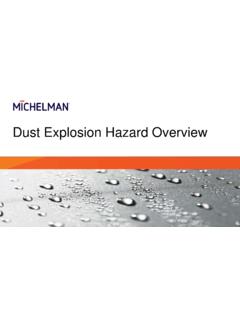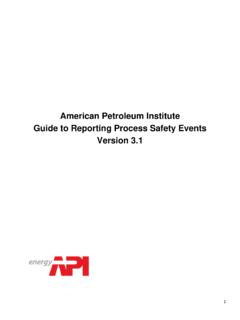Transcription of Process Safety Leading and Lagging Metrics
1 2007 2009 2011 2013 2015 PSI Count PSI Rate PSI Severity Rate PS Industry Wide Metric Process SafetyLeading and Lagging Don t Improve What You Don t MeasureCCPSAn AIChE Te chnology AllianceCenter for Chemical Process Safety2013 2015 Revised: January 20112 CCPSAn AIChE Technology AllianceCenter for Chemical Process SafetyCCCCCPSPSPAn AIChE Technology AllianceCenter for Chemical Process SafetyCenter for Chemical Process SafetyAn AIChE IndustryTechnology AllianceProcess Safety Leading and Lagging MetricsYou Don t Improve What You Don t MeasurePrefaceThe Center for Chemical Process Safety (CCPS ) was established in 1985 by the American Institute of Chemical Engineers (AIChE) for the express purpose of assisting industry in avoiding or mitigating catastrophic chemical accidents.
2 More than 130 corporate members around the world drive the activities of 2006, the CCPS Technical Steering Committee authorized the creation of a project committee to develop a Guideline book for the development and use of Leading and Lagging Process Safety Metrics . That committee identified that a key breakthrough opportunity for industry was the development of an industry Lagging metric that would become the benchmark across the chemical and petroleum industry for measuring Process Safety performance . To achieve this objective, representatives and members from each of the major chemical and petroleum trade associations as well as other key global stakeholders were engaged.
3 The outcome of that effort was published in December 2007. Many companies and organizations have used those metric definitions since 2008. Those definitions established in 2007 were a key input to the creation of a new ANSI/API standard (ANSI/API RP 754), which has been finalized and released in April 2010. CCPS and several members of the original CCPS Metric committee were involved in the API standard committee. CCPS has elected to update the original (December 2007) document describing the CCPS metric recommendations with minor revisions with the intent to align the CCPS and API documents.
4 The intent is that if a company or organization utilizes either the CCPS or API definitions for the top tier Process Safety incident definitions that they will count the same incidents. However, there are a few principles described in the CCPS metric document which are not incorporated in the API document ( , the description and use of a severity-weighted metric). Since the API document references the CCPS definition it is important to retain both documents, yet maintain good alignment between the are also a few additions incorporated into the ANSI/API RP 754 document which may not be deemed necessary by all companies or trade associations internationally that have already began utilizing the 2007 CCPS document ( , the definitions of a Tier 2 Process Safety event).
5 This updated CCPS metric document will note those differences, yet describe those as optional Metrics or ultimate goal of the 2006 CCPS project was to develop and then promote the use of common Metrics across the industry and around the world. CCPS continues to support that objective, whether via adoption of the ANSI/API RP 754 definitions or via use of this Petroleum Institute, ANSI/API Recommended Practice 754, Process Safety performance Indicators for the Refining and Petrochemical Industries, First Edition, Washington , more information on CCPS or these Metrics please visit Process Safety Metrics You don t improve what you don t measure Lagging Metrics .
6 6 Process Safety Incident (PSI) (Tier 1 - PSE as per API-754): ..6 Process Involvement ..6 Reporting Thresholds ..7 Location ..9 Acute Release ..9 Flowchart ..9 Tier 2 Process Safety Events (Tier 2 - PSE as per API 754) ..12 Tier 2 indicator Purpose ..12 Process Involvement ..12 Tier 2 indicator Definition and Consequences ..12 Definitions ..14 Rate Adjusted Metrics ..17 Industry Process Safety Metrics ..17 Applicability ..18 Interpretations and Examples ..19II. Leading Metrics ..28 Mechanical Integrity.
7 29 Action Items Follow-up ..30 Management of Change ..30 Process Safety Training and Competency ..33 Safety Culture ..33 Operating & Maintenance Procedures ..34 Fatigue Risk Management ..35 III. Near Miss Reporting and other Lagging Metrics ..35 Definition of a Process Safety Near Miss ..36 Examples of Process Safety Near Miss ..36 Maximizing Value of Near Miss Reporting ..38 Appendix A: UN Dangerous Goods Classification and Listing Chemicals ..38 Appendix B: Additional Clarifications regarding UN Dangerous Goods lists & Exceptions.
8 414 CCPSAn AIChE Technology AllianceCenter for Chemical Process SafetyCCCCCPSPSPAn AIChE Technology AllianceCenter for Chemical Process SafetyCenter for Chemical Process SafetyAn AIChE IndustryTechnology AllianceProcess Safety Leading and Lagging MetricsYou Don t Improve What You Don t MeasureIntroductionAn essential element of any improvement program is the measure of existing and future performance . Therefore, to continuously improve upon Process Safety performance , it is essential that companies in the chemical and petroleum industries implement effective Leading and Lagging Process Safety Metrics .
9 This document describes the recommenda-tions assembled by the Center for Chemical Process Safety (CCPS) Process Safety Metric committee for a common set of company and industry Leading and Lagging this document is a description of three types of Metrics : Lagging Metrics a retrospective set of Metrics that are based on incidents that meet the threshold of severity that should be reported as part of the industry-wide Process Safety metric. Leading Metrics a forward looking set of Metrics which indicate the performance of the key work processes, operating discipline, or layers of protection that prevent incidents Near Miss and other internal Lagging Metrics the description of less severe incidents ( , below the threshold for inclusion in the industry Lagging metric), or unsafe conditions which activated one or more layers of protection.
10 Although these events are actual events ( , a Lagging metric), they are generally considered to be a good indicator of conditions which could ultimately lead to a more severe three types of Metrics can be considered as measurements at different levels of the Safety pyramid illustrated in Figure 1. Although Figure 1 is divided into four separate layers ( Process Safety incidents, Other incidents, Near miss, and Unsafe behaviors/Insufficient operating discipline), it is easier to describe Metrics in terms of the categories shown above. Figure 1 illustrates how each of these four areas is captured under the three sections of this is strongly recommended that all companies incorporate each of these three types of Metrics into their internal Process Safety management system.










